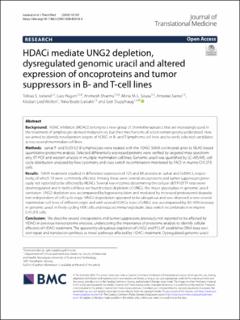| dc.contributor.author | Iveland, Tobias Solli | |
| dc.contributor.author | Hagen, Lars | |
| dc.contributor.author | Sharma, Animesh | |
| dc.contributor.author | Sousa, Mirta | |
| dc.contributor.author | Sarno, Antonio | |
| dc.contributor.author | Kristian Lied, Wollen | |
| dc.contributor.author | Liabakk, Nina-Beate | |
| dc.contributor.author | Slupphaug, Geir | |
| dc.date.accessioned | 2020-09-29T11:15:27Z | |
| dc.date.available | 2020-09-29T11:15:27Z | |
| dc.date.created | 2020-06-11T08:45:54Z | |
| dc.date.issued | 2020 | |
| dc.identifier.issn | 1479-5876 | |
| dc.identifier.uri | https://hdl.handle.net/11250/2680259 | |
| dc.description.abstract | Background
HDAC inhibitors (HDACi) belong to a new group of chemotherapeutics that are increasingly used in the treatment of lymphocyte-derived malignancies, but their mechanisms of action remain poorly understood. Here we aimed to identify novel protein targets of HDACi in B- and T-lymphoma cell lines and to verify selected candidates across several mammalian cell lines.
Methods
Jurkat T- and SUDHL5 B-lymphocytes were treated with the HDACi SAHA (vorinostat) prior to SILAC-based quantitative proteome analysis. Selected differentially expressed proteins were verified by targeted mass spectrometry, RT-PCR and western analysis in multiple mammalian cell lines. Genomic uracil was quantified by LC–MS/MS, cell cycle distribution analyzed by flow cytometry and class switch recombination monitored by FACS in murine CH12F3 cells.
Results
SAHA treatment resulted in differential expression of 125 and 89 proteins in Jurkat and SUDHL5, respectively, of which 19 were commonly affected. Among these were several oncoproteins and tumor suppressors previously not reported to be affected by HDACi. Several key enzymes determining the cellular dUTP/dTTP ratio were downregulated and in both cell lines we found robust depletion of UNG2, the major glycosylase in genomic uracil sanitation. UNG2 depletion was accompanied by hyperacetylation and mediated by increased proteasomal degradation independent of cell cycle stage. UNG2 degradation appeared to be ubiquitous and was observed across several mammalian cell lines of different origin and with several HDACis. Loss of UNG2 was accompanied by 30–40% increase in genomic uracil in freely cycling HEK cells and reduced immunoglobulin class-switch recombination in murine CH12F3 cells.
Conclusion
We describe several oncoproteins and tumor suppressors previously not reported to be affected by HDACi in previous transcriptome analyses, underscoring the importance of proteome analysis to identify cellular effectors of HDACi treatment. The apparently ubiquitous depletion of UNG2 and PCLAF establishes DNA base excision repair and translesion synthesis as novel pathways affected by HDACi treatment. Dysregulated genomic uracil homeostasis may aid interpretation of HDACi effects in cancer cells and further advance studies on this class of inhibitors in the treatment of APOBEC-expressing tumors, autoimmune disease and HIV-1. | en_US |
| dc.language.iso | eng | en_US |
| dc.publisher | BMC (part of Springer Nature) | en_US |
| dc.rights | Navngivelse 4.0 Internasjonal | * |
| dc.rights.uri | http://creativecommons.org/licenses/by/4.0/deed.no | * |
| dc.title | HDACi Mediate UNG2 Depletion, Dysregulated Genomic Uracil and Altered Expression of Oncoproteins and Tumor Suppressors in B- And T-cell Lines | en_US |
| dc.type | Peer reviewed | en_US |
| dc.type | Journal article | en_US |
| dc.description.version | publishedVersion | en_US |
| dc.source.volume | 18 | en_US |
| dc.source.journal | Journal of Translational Medicine | en_US |
| dc.identifier.doi | 10.1186/s12967-020-02318-8 | |
| dc.identifier.cristin | 1814956 | |
| dc.description.localcode | Open Access This article is licensed under a Creative Commons Attribution 4.0 International License, which permits use, sharing, adaptation, distribution and reproduction in any medium or format, as long as you give appropriate credit to the original author(s) and the source, provide a link to the Creative Commons licence, and indicate if changes were made. The images or other third party material in this article are included in the article's Creative Commons licence, unless indicated otherwise in a credit line to the material. If material is not included in the article's Creative Commons licence and your intended use is not permitted by statutory regulation or exceeds the permitted use, you will need to obtain permission directly from the copyright holder. To view a copy of this licence, visit http://creativecommons.org/licenses/by/4.0/. The Creative Commons Public Domain Dedication waiver (http://creativecommons.org/publicdomain/zero/1.0/) applies to the data made available in this article, unless otherwise stated in a credit line to the data. | en_US |
| cristin.ispublished | true | |
| cristin.fulltext | original | |
| cristin.qualitycode | 1 | |

